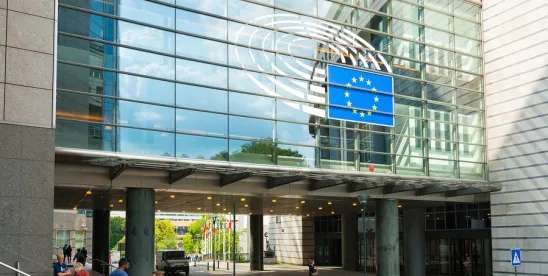ANTITRUST AND COMPETITION
Commission Approves €900 Million German Scheme to Support Investments in Production of Green Hydrogen
The purpose of the scheme entitled “H2Global” is to advance the international market expansion of renewable hydrogen, which is expected to significantly increase in the coming years. It is designed in a way to enable only the most cost-effective projects to be supported, reducing costs for taxpayers without unduly distorting competition in the single market, given the existence of competitive bidding processes in which a large number of potential firms can participate.
The “H2Global” project has an estimated budget of €900 million and will run for 10 years starting from the award of the first contract. It will be managed and implemented by a special-purpose entity named HINT.CO, which will conclude long-term purchase contracts on the supply side of green hydrogen production and short-term resale contracts on the demand side for green hydrogen usage.
The funds will be granted through competitive tenders, while the prices will be determined on the buying and selling side through a double auction model, where the lowest bid price for hydrogen production and the highest selling price for hydrogen consumption will each be awarded a contract.
Producers of renewable hydrogen and hydrogen derivatives, such as green ammonia, green methanol, and e-Kerosene, wishing to participate in the tenders must strictly comply with the sustainability criteria set out in the revised Renewable Energy Directive.
European Commission Opens Investigation into Licencing and Distribution Practices of a Global Fashion Brand and its Main Licensee
On 31 January 2022, the European Commission (the Commission) opened an investigation into the licensing and distribution practices of a global fashion brand and its main licensee—a German clothing manufacturer—(together, the Parties) for an alleged breach of EU competition rules in the European Economic Area (the Investigation). The Investigation followed unannounced inspections (i.e., dawn raids) conducted by the Commission at the licensee’s premises in Germany in June 2021. The Commission officials were accompanied by their counterparts from the German competition authority. On the basis of the evidence gathered during the dawn raids, the Commission prima facie found that the Parties’ licensing and distribution system could raise serious competition concerns insofar as it would restrict cross-border sales of the brand-licensed products such as clothes, shoes, and accessories.
The Commission is concerned that the Parties may have restricted both offline and online sales of the brand-licensed products and the sales to specific customer groups by enforcing restrictions in the licensing agreements. In particular, the Commission intends to assess whether the distribution practices implemented by the Parties could result in a strategy against parallel imports and sales to specific customers groups, in breach of EU competition law.
If proven, such practices could lead to an illegal fragmentation of the EU’s single market and expose the Parties to substantial fines up to 10% of their global turnover in the last financial year. To avoid lengthy proceedings, the Parties made public their intention to cooperate with the Commission on the basis of the cooperation procedure in antitrust cases. Under such a procedure, the Commission may reward the Parties’ cooperation with a significant fine reduction. In previous cases, the Commission has reduced fines by 20% – 50%.
Overall, the Commission continues to closely scrutinize alleged anti-competitive behaviour in the fashion sector in Europe where a number of global brands have been fined in the last few years. Investigated brands have generally opted to close the proceedings and benefit from significant fines reduction on the basis of the cooperation procedure with the Commission. In 2018, the Commission imposed a €40 million fine on a fashion brand after a 50% reduction for cooperation. Similarly, the Commission imposed in 2019 a €12.5 million fine on another fashion brand after a 40% reduction for cooperation.
The Commission will introduce new EU rules shortly. These rules will govern distribution agreements and online sales until 2032 replace the current EU Vertical Block Exemption Regulation and Vertical Guidelines, which expire on 31 May 2022. Brands, marketplaces, and other players in the supply and distribution chain should assess their distribution structures and policies to flag areas that might need revision or clarification to ensure compliance going forward, as well as to identify opportunities where they can take advantage of the additional flexibility.
DIGITAL AFFAIRS
European Chips Act Unveiled
On 8 February 2022, the Commission revealed the European Chips Act (Chips Act) proposal, a set of measures to ensure EU’s supply chain security, resilience, and leadership in semiconductor technology and applications. The objective is to increase Europe’s competitiveness, capabilities, and resilience, making Europe a leader in the global semiconductor market with an increased market share of up to 20% by 2030.
The Commission’s proposal is a response to global shortages of semiconductors, exacerbated by the pandemics, which caused decreased production and forced closures of factories in a range of sectors, from cars to healthcare services. The Chips Act aims to address these problems by making use of the EU’s R&D networks, equipment manufacturers, and mechanisms to anticipate and quickly respond to any future supply chain issues. For that purpose, the EU and the member states will make available €11 billion, with the goal of mobilizing more than €43 billion in public and private investments. Through the Chips Act, the European Union will adapt its state aid rules to the specific case of semiconductors and its industrial, economic, and strategic constraints. In times of supply chain shortages, the European Union proposes export controls as a measure of last resort.
Main features of the Chips Act are:
-
Chips for Europe Initiative, which will make available €11 billion to strengthen EU’s competences in semiconductor R&D and production;
-
A new framework to ensure security of supply chains and enhanced production capacities, by attracting investments and production capacities;
-
A coordination mechanism between member states and the Commission, to monitor the supply chain and to map weaknesses and bottlenecks.
The European Parliament and the Council of the EU (with representatives from each member state) will discuss the Commission’s proposals on a Chips Act in the ordinary legislative procedure. If adopted, the Regulation will be directly applicable across the European Union.
French Presidency Pushes Ahead with Artificial Intelligence Act
In January 2022, the French presidency sent a partial compromise text to EU diplomats regarding articles 8 to 15 and Annex IV of the proposed Artificial Intelligence (AI) Act (AI Act). The definition of “risk” of the AI systems is one of the main issues for discussion with the French presidency aiming to clarify which AI systems shall fall under the “high-risk” category. According to the text, an AI system should be identified as high-risk when the AI technology used could present risks to “health, safety, and fundamental rights.” Some member states argue that economic risk should also be addressed in that same category. Another topic suggestion in the compromise text is that providers of AI high-risk systems shall be liable for ensuring their systems have human oversight. Finally, the French presidency also argues that the Commission’s objective for data sets to be completely free of error is unrealistic and that the proposal should aim for data sets to be complete and free of error to the “best extent possible.”
During the week of 7 to 11 February, the French presidency circulated in the Council of the European Union (EU Council) another partial compromise text now dealing with articles 16 to 29 of the proposed AI Act. The text includes more substantial requirements for high-risk AI system providers, especially in terms of transparency, tracing, and cooperation with users. The text also clarifies obligations for third-parties service providers and their liability as part of the value chain. Along those lines, more responsibility for authorized representatives of non-EU providers has been added in relation to defective systems. Finally, the French presidency’s text also clarifies the obligations for importers and distributors.
The European Commission proposal for a new AI Act was originally published in April 2021 and focused on the utilization of AI systems and their consequent risks. According to the proposal, risks can be categorized as unacceptable, high, limited, or minimal.
Under the Slovenian presidency (second half of 2021), the Council identified areas where progress needed to be made like the requirements for high-risk systems, the complexity of the value chain or the excessive administrative burden that SME’s would have to face to comply with the regulation.
The objective of the French presidency is for the EU Council to discuss the entire AI Act by the end of February and publish a consolidated compromise text in March.
Commission Publishes a Final Report on Its Consumer Internet of Things Sector Inquiry
The final findings of the sector inquiry largely confirm the concerns already identified in the Commission’s preliminary report published in June 2021, describing a market with high barriers to entry, few vertically integrated players and concerns about various interoperability issues, access to data, and exclusivity practices.
Most of the stakeholders who participated in the sector inquiry indicated that the cost of the technology investment and the competitive situation are the main barriers to entry or expansion in the consumer Internet of Things (IoT) sector. Consistent with the preliminary report, the Commission’s Final Report notably describes the concerns raised in relation to interoperability, extensive access to data exclusivity and tying practices that could have a negative impact on competition, innovation, and consumer choice in the sector. In relation to interoperability, stakeholders raised concerns on the lack of interoperability in the consumer IoT sector due to the prevalence of proprietary technology, leading at times to the creation of de facto standards. In particular, certain providers of voice assistants and operating systems are considered to unilaterally control interoperability and integration processes and to be capable of limiting functionalities of third-party smart devices and consumer IoT services, compared to their own.
The Commission indicated that the findings of the sector inquiry will provide guidance to its enforcement and regulatory activity, and will inform its further work in implementing its digital strategy, as well as in contributing to the ongoing legislative debate on the Digital Markets Act’s (DMA) proposal.
ECONOMIC AND FINANCIAL AFFAIRS
ESRB ASC Discusses Digitalization and the Future of Banking
On 18 January, the European Systemic Risk Board’s (ESRB) Advisory Scientific Committee (ASC) published a report titled “Will video kill the radio star? – Digitalization and the future of banking.” The report first looks at the recent wave of technology-induced financial innovation. It then considers how digitalization could change the way financial and banking services are provided, identifies emerging financial and non-financial risks, and proposes possible macroprudential policy responses.
In particular, the report discusses the risks posed by digital financial innovation in the form of new financial services providers (i.e., Fintech companies and big tech firms) that cover a variety of financial services in aggregate. As big tech firms, which generally operate through platforms, derive advantages from their data analytics, network externalities and interwoven activities, incumbent banks are facing greater competition across business lines. Moreover, while incumbent banks may take greater risks to increase their competiveness, the new providers that enter with bank-like intermediation models are subject to the known risks in banking, such as liquidity risk, credit risk, and market risk. This could potentially trigger system-wide risk. Additionally, digitalization poses non-financial risks, especially those stemming from: i) greater concentration of the provision of basic services, such as cloud computing; ii) broader use of AI in finance; iii) overly automated or IT-oriented services that may be more prone to cyberattacks; iv) trust in a leading technology that might unexpectedly turn obsolete; and v) a false sense of security from overleveraging insights from AI.
The report defines three hypothetical scenarios for the EU financial system in 2030, which form the basis for proposing possible macro-prudential policy responses. In the first scenario, incumbent banks continue to dominate, retaining their central role in the areas of money creation and financial intermediation. In the second scenario, incumbent banks retrench, while big tech firms capture the hard data, transaction-based lending market, leading to a structural shift in the financial system. In the third scenario, the issuance of retail central bank digital currencies, under certain intermediation models, leads to a different structure of the financial system. Based on the three hypothetical scenarios, the report proposes a number of policy measures to address the financial and non-financial risks associated with digitalization. Whereas some of the measures would apply to all three scenarios, others would be more relevant if only one of the three scenarios materializes.
European Systemic Risk Board Recommends Increasing the Resilience of Money Market Funds
On 25 January, the ESRB published its recommendations on the reform of money market funds (MMFs) and an accompanying report on the economic rationale supporting the recommendations. The ESRB takes the view that the regulatory changes in the wake of the 2008 global financial crisis did not sufficiently address all systemic risks in the MMF sector, as seen in 2020 at the onset of the COVID-19 pandemic, and therefore recommends policy reforms to address the remaining sources of systemic risk.
Building upon the ESRB’s July 2021 issues note on systemic vulnerabilities in MMFs and preliminary policy considerations for their reform and reflecting on previous policy discussions such as the Financial Stability Board’s October 2021 policy proposals to enhance the resilience of MMFs, these recommendations contribute to the Commission’s forthcoming 2022 review of Regulation (EU) 2017/1131 (the MMFR). Specifically, the ESRB recommends that the Commission:
-
Reduce threshold effects that increase first-mover advantages, including by amending the features that make MMFs similar to deposit-taking institutions;
-
Reduce liquidity transformation by diversifying asset portfolios and improving their liquidity through requirements to hold public debt assets and by making sure that such liquidity can be used when needed;
-
Facilitate the use of liquidity management tools that impose trading costs on redeeming investors; and
-
Enhance monitoring and stress-testing frameworks.
Alessandro Di Mario, Antoine De Rohan Chabot, Nicolas Hipp, Stefano Prinzivalli Castelli, Petr Bartoš, Joanna Kulewska, Matilde Manzi, and Inês S. Mendes contributed to this articke.






 />i
/>i

